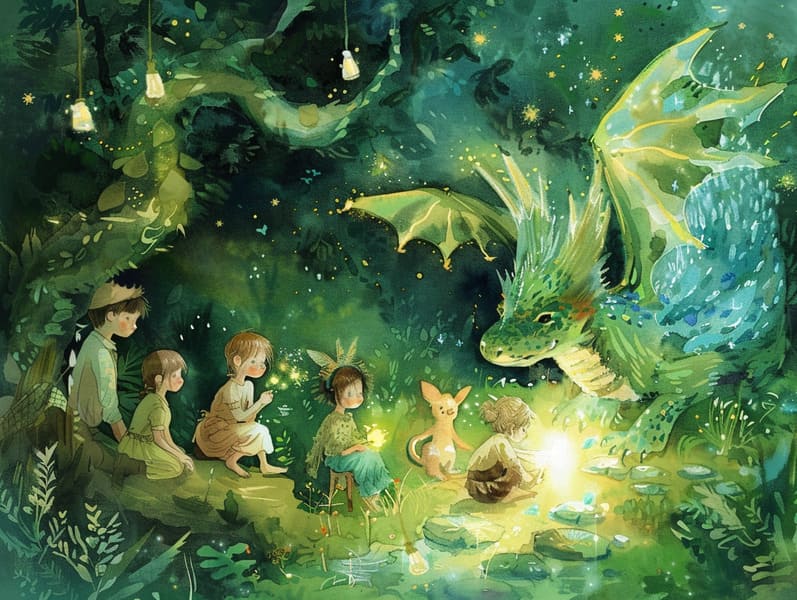The Beginning of Children's Fairy Tales with Its Undying Mystique.
The Beginning of Children's Fairy Tales with Its Undying Mystique.
Blog Article

Ancient fairy tales have enduring presence. These tales have been transmitted from one generation to the next long before they were ever inscribed. They sprang from a variety of backgrounds, including Eastern traditions. They were initially told among older generations, often carrying themes and messages reflective of the societal norms and beliefs of the time.
The Grimm brothers, Jacob and Wilhelm (the Grimm brothers), were among the first to compile and release many of these beloved tales. Their anthology, "Grimm's Fables," included stories like "Cinderella," "The Bread Crumb Trail," and "Schneewittchen," which have since become hallmarks in the world of famous fairy tales. Similarly, H. C. Andersen's fanciful stories, such as "The Mermaid's Tale," and "The Little Duckling," have captivated hearts worldwide, ensuring their place in the pantheon of classic fairy tales.
Despite their historical roots, fairy tales remain as significant as ever, especially as bedtime stories for kids. These whimsical stories are now available in many formats, including beautifully illustrated books, delightful animations, and internet fairy tales.
Their lasting presence can be credited to several delightful features:
Life Lessons: Classic fairy tales often share important moral lessons. Stories like "The Tale of the Boy Who Cried Wolf" teach the importance of being truthful, while "The Tortoise and the Hare" show the values of persistence and modesty. These stories offer the young clear distinctions between correct and incorrect, shaping their moral compass in a gentle yet deep way.
Compassion and Insight: Old fairy tales frequently showcase characters facing challenges and struggles, urging listeners to sympathize with their struggles and root for their triumphs. For instance, "Beauty and the Beast" highlights the importance of valuing inner qualities to comprehend the inner spirit of a being, promoting tenderness and knowledge.
Cultural Appreciation: Many traditional fairy tales are saturated in the cultural contexts from which they were born. Exploring these stories can provide informative snapshots into different historical contexts, advancing a sense of international awareness and discernment.
Creativity and Imagination: The fantastical elements in traditional fairy tales—magic wands—spark children’s innovative ideas. These narratives take readers to extraordinary realms, provoking imaginative dreams and a sense of amazement that stays a lifetime.
Traditional fairy tales are not only charming but also enlightening. They provide charming tools in cultivating various thinking and feeling skills in little ones. When classic fairy tales are voiced, they improve language proficiency by showing new language and elaborate sentence structures. This practice also nurtures hearing perception and attentiveness, as young ones concentrate deeply, expectant to see what happens next.
Furthermore, contemplating the themes and characters of ancient fairy tales can nurture evaluative skills and critical thinking. Kids are educated to discover patterns, expect results, and make sense of cause and effect. These deliberations also assist the young express their thoughts and feelings, fostering their emotional intelligence.
In today’s modern era, the prevalence of internet fairy tales has made these stories more within reach than ever. Online platforms and apps supply wide arrays of famous fairy tales that can be browsed or heard anytime, anywhere. Fairy tales read out loud are particularly well-liked, giving an interactive method for young readers to enjoy these fascinating tales. Audiobooks and read-out-loud website videos guide characters and settings to life, often enhanced by charming sound effects and songs that heighten the tale-telling adventure.
The lasting allure of timeless fairy tales lies in their ability to transform to the present while holding onto their fundamental ideas. Contemporary revisions of these fairy tales often showcase more varied protagonists and modern settings, making them accessible to today’s audience. However, the essential messages of guts, goodness, and lawfulness remain unchanged, continuing to impact young listeners of all ages.
Ancient fairy tales also offer a sense of assurance and homeliness. They highlight a systematic narrative with a straightforward beginning, middle, and end, often ending with the resolution of conflicts and the triumph of justice over injustice. This reliability can be encouraging for kids, affording a sense of unchangeability in an constantly changing world.
Old fairy tales continue to fascinate and edify new generations, maintaining their majesty and significance in modern society. As nighttime stories for kids, they put out a perfect blend of allure and teaching, cultivating moral values, empathy, and creativity. The availability of online fairy tales and the popularity of fairy tales recited validate that these ancient tales remain attainable to new generations.
By upholding and conveying these stories, we continue to venerate the rich tapestry of fantasy and cultural heritage. Whether you are enjoying a vibrantly illustrated book, accessing a cyber library, or listening on an spoken story, the splendor of bedtime fairy tales is always within reach. These tales emphasize of the endless strength of stories and its ability to connect us across epochs and places.
Even if you are browsing a artistically illustrated book, delving into a web-based library, or playing an read-aloud book, the grandeur of ancient fairy tales is always within reach.
These fairy tales reveal of the immortal nature of storytelling and its ability to draw us together across centuries and lands, creating a bond that fascinates and enlightens alike.